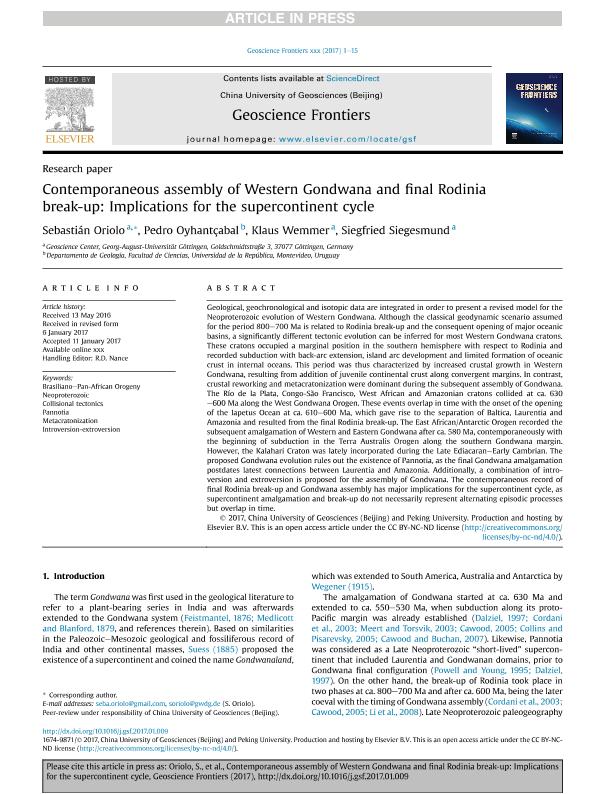Mostrar el registro sencillo del ítem
dc.contributor.author
Oriolo, Sebastián

dc.contributor.author
Oyhantçabal, Pedro
dc.contributor.author
Wemmer, Klaus

dc.contributor.author
Siegesmund, Siegfried

dc.date.available
2018-11-28T17:39:04Z
dc.date.issued
2017-11
dc.identifier.citation
Oriolo, Sebastián; Oyhantçabal, Pedro; Wemmer, Klaus; Siegesmund, Siegfried; Contemporaneous assembly of Western Gondwana and final Rodinia break-up: Implications for the supercontinent cycle; Elsevier Science; Geoscience Frontiers; 8; 6; 11-2017; 1431-1445
dc.identifier.issn
1674-9871
dc.identifier.uri
http://hdl.handle.net/11336/65452
dc.description.abstract
Geological, geochronological and isotopic data are integrated in order to present a revised model for the Neoproterozoic evolution of Western Gondwana. Although the classical geodynamic scenario assumed for the period 800–700 Ma is related to Rodinia break-up and the consequent opening of major oceanic basins, a significantly different tectonic evolution can be inferred for most Western Gondwana cratons. These cratons occupied a marginal position in the southern hemisphere with respect to Rodinia and recorded subduction with back-arc extension, island arc development and limited formation of oceanic crust in internal oceans. This period was thus characterized by increased crustal growth in Western Gondwana, resulting from addition of juvenile continental crust along convergent margins. In contrast, crustal reworking and metacratonization were dominant during the subsequent assembly of Gondwana. The Río de la Plata, Congo-São Francisco, West African and Amazonian cratons collided at ca. 630–600 Ma along the West Gondwana Orogen. These events overlap in time with the onset of the opening of the Iapetus Ocean at ca. 610–600 Ma, which gave rise to the separation of Baltica, Laurentia and Amazonia and resulted from the final Rodinia break-up. The East African/Antarctic Orogen recorded the subsequent amalgamation of Western and Eastern Gondwana after ca. 580 Ma, contemporaneously with the beginning of subduction in the Terra Australis Orogen along the southern Gondwana margin. However, the Kalahari Craton was lately incorporated during the Late Ediacaran–Early Cambrian. The proposed Gondwana evolution rules out the existence of Pannotia, as the final Gondwana amalgamation postdates latest connections between Laurentia and Amazonia. Additionally, a combination of introversion and extroversion is proposed for the assembly of Gondwana. The contemporaneous record of final Rodinia break-up and Gondwana assembly has major implications for the supercontinent cycle, as supercontinent amalgamation and break-up do not necessarily represent alternating episodic processes but overlap in time.
dc.format
application/pdf
dc.language.iso
eng
dc.publisher
Elsevier Science

dc.rights
info:eu-repo/semantics/openAccess
dc.rights.uri
https://creativecommons.org/licenses/by-nc-nd/2.5/ar/
dc.subject
Brasiliano&Ndash;Pan-African Orogeny
dc.subject
Collisional Tectonics
dc.subject
Introversion-Extroversion
dc.subject
Metacratonization
dc.subject
Neoproterozoic
dc.subject
Pannotia
dc.subject.classification
Meteorología y Ciencias Atmosféricas

dc.subject.classification
Ciencias de la Tierra y relacionadas con el Medio Ambiente

dc.subject.classification
CIENCIAS NATURALES Y EXACTAS

dc.title
Contemporaneous assembly of Western Gondwana and final Rodinia break-up: Implications for the supercontinent cycle
dc.type
info:eu-repo/semantics/article
dc.type
info:ar-repo/semantics/artículo
dc.type
info:eu-repo/semantics/publishedVersion
dc.date.updated
2018-10-23T21:20:24Z
dc.journal.volume
8
dc.journal.number
6
dc.journal.pagination
1431-1445
dc.journal.pais
Países Bajos

dc.journal.ciudad
Amsterdam
dc.description.fil
Fil: Oriolo, Sebastián. Universität Göttingen; Alemania. Consejo Nacional de Investigaciones Científicas y Técnicas. Oficina de Coordinación Administrativa Ciudad Universitaria. Instituto de Ecología, Genética y Evolución de Buenos Aires. Universidad de Buenos Aires. Facultad de Ciencias Exactas y Naturales. Instituto de Ecología, Genética y Evolución de Buenos Aires; Argentina
dc.description.fil
Fil: Oyhantçabal, Pedro. Universidad de la República; Uruguay
dc.description.fil
Fil: Wemmer, Klaus. Universität Göttingen; Alemania
dc.description.fil
Fil: Siegesmund, Siegfried. Universität Göttingen; Alemania
dc.journal.title
Geoscience Frontiers
dc.relation.alternativeid
info:eu-repo/semantics/altIdentifier/doi/https://dx.doi.org/10.1016/j.gsf.2017.01.009
dc.relation.alternativeid
info:eu-repo/semantics/altIdentifier/url/https://www.sciencedirect.com/science/article/pii/S1674987117300294
Archivos asociados
